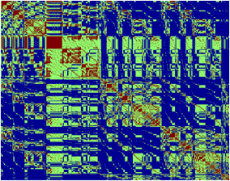Building a Universal Nuclear Energy Density Functional

Collaboration with mathematicians and computational scientists is vital for success in developing a universal nuclear density functional. Above you can see a schematic of one of the matrices generated in this work. Red=-non-zeros, Blue=zero blocks, and Green=potentially zero blocks.
Key Challenges
The objective is to accurately predict properties of exotic nuclei from first principles. This invovles direct solution of the nuclear many-body problem by diagonalization in a sufficiently large basis space that converged binding energies are accessed, either directly or by simple extrapolation. The ab initio no core shell model (NCSM) and the no core full configuration (NCFC) method, frame the nuclear quantum many-particle problem as a large sparse matrix eigenvalue problem. The dimensions of the Hamiltonian matrix required grow combinatorially with increasing many-body basis states and with increasing atomic number. The computations of desired moderate-sized nuclei rapidly exceed the memories available on all current high-performance computing systems.
Why it Matters
Exotic nuclei at the nucleon drip lines and beyond constitute a forefront research area in nuclear physics. Many fundamental properties of nuclei are poorly understood today. A a quantitative understanding based on the underlying strong inter-nucleon potentials will allow a predictive capability for key properties of short-lived or undiscovered nuclei. New medical diagnostic and therapeutic applications may emerge as exotic nuclei are predicted and produced in the laboratory.
Accomplishments
The Many Fermion Dynamics–nuclear (MFDn) code was developed at NERSC over a period of about two decades and was recently used to evaluate excited states in the 6Li nucleus. This approach to extrapolating the total eigenenergies helped support calculations related to the exotic, proton-rich 14F nucleus. The predictions arising from these calculations served as motivation for experiments that ultimately achieved the first observation of the14F nucleus. Ground-state and first excited state energies of the 16O nucleus were also calculated using a no-core shell model and no-core full configuration interaction model. These were the first of a kind, most accurate calculations for this size nucleus ever and involved diagonalization of matrices of dimension up to 1 billion in 4.5 hrs.
In 2011 MFDn computations have used up to 2,556 nodes (10,224 cores) on Franklin and 5,382 nodes (129,168 cores) on Hopper.
Principal Investigators
P. Maris and J. P. Vary (Iowa State) and Joseph Carlson (LANL)
More Information
See Phys. Rev. C 81, 021301(R) (2010), Phys. Rev. C 79, 014308 (2009), and the http://unedf.org/ web site.







